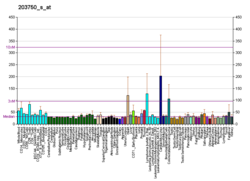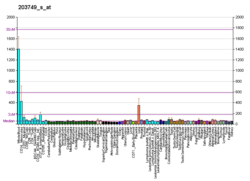レチノイン酸受容体α
レチノイン酸受容体α(英: retinoic acid receptor alpha、略称: RARα)またはNR1B1(nuclear receptor subfamily 1, group B, member 1)は、ヒトではRARA遺伝子にコードされる核内受容体である[5][6]。
RARA遺伝子は17番染色体17q21.2に位置し、転写因子として機能する核内ホルモン受容体をコードする。レチノイン酸受容体(RAR)はRARαの他に、RARβ、RARγの2種類が存在する[7][8]。
機能
[編集]レチノイドシグナルは、レチノイン酸受容体(RAR)とレチノイドX受容体(RXR)の2種類の核内受容体ファミリーからなるRXR/RARヘテロ二量体によって伝達される。リガンドが存在しない場合には、DNAに結合したRXR/RARαはコリプレッサーであるNCOR1、NCOR2(SMRT)、そしてヒストンデアセチラーゼをリクルートすることで転写を抑制する。リガンドが複合体に結合すると、コンフォメーション変化が生じてコアクチベーター、ヒストンアセチルトランスフェラーゼ、基本転写装置のリクルートが可能となる[8]。RARαはビタミンA誘導体であるレチノイン酸と相互作用し、細胞成長、分化、胚発生時の器官形成に重要な役割を果たす[8][9]。
臨床的意義
[編集]レチノイン酸シグナルは、初期胚発生時のいくつかのシグナル伝達経路と関係している。レチノイン酸は体軸の形成に関与しており、対称性を確立する。また、レチノイン酸はプロニューラル因子であるニューロゲニン2(Neurog2)の発現を調節することで神経分化に影響を与える。レチノイン酸は心臓形成にも影響を与え、具体的には心房の形成に関与している。また、膵臓、腎臓、肺、四肢の発生にも関与している[9]。
RARA遺伝子の再配置を伴う染色体転座は、急性前骨髄球性白血病(APL)の主要な特徴である。最も高頻度でみられる転座はt(15,17)(q21;q22)であり、RARA遺伝子がPML遺伝子と融合している[10]。
相互作用
[編集]RARαは次に挙げる因子と相互作用することが示されている。
リガンド
[編集]アンタゴニスト
[編集]- BMS-189453(非選択的)
- YCT529 (RARα選択的)
出典
[編集]- ^ a b c GRCh38: Ensembl release 89: ENSG00000131759 - Ensembl, May 2017
- ^ a b c GRCm38: Ensembl release 89: ENSMUSG00000037992 - Ensembl, May 2017
- ^ Human PubMed Reference:
- ^ Mouse PubMed Reference:
- ^ “Identification of a receptor for the morphogen retinoic acid”. Nature 330 (6149): 624–9. (1987). Bibcode: 1987Natur.330..624G. doi:10.1038/330624a0. PMID 2825036.
- ^ “High-density genetic map of the BRCA1 region of chromosome 17q12-q21”. Genomics 17 (3): 618–23. (September 1993). doi:10.1006/geno.1993.1381. PMID 8244378.
- ^ “Gene symbol report | HUGO Gene Nomenclature Committee”. www.genenames.org. 2021年4月27日閲覧。
- ^ a b c “OMIM Entry - * 180240 - RETINOIC ACID RECEPTOR, ALPHA; RARA”. www.omim.org. 2021年4月27日閲覧。
- ^ a b “Retinoic acid synthesis and functions in early embryonic development”. Cell & Bioscience 2 (1): 11. (March 2012). doi:10.1186/2045-3701-2-11. PMC 3325842. PMID 22439772.
- ^ “Acute promyelocytic leukemia: new issues on pathogenesis and treatment response”. The International Journal of Biochemistry & Cell Biology 39 (6): 1063–70. (2007). doi:10.1016/j.biocel.2007.01.028. PMID 17468032.
- ^ “Interaction of BAG-1 with retinoic acid receptor and its inhibition of retinoic acid-induced apoptosis in cancer cells”. The Journal of Biological Chemistry 273 (27): 16985–92. (July 1998). doi:10.1074/jbc.273.27.16985. PMID 9642262.
- ^ a b “Regulation of CLOCK and MOP4 by nuclear hormone receptors in the vasculature: a humoral mechanism to reset a peripheral clock”. Cell 105 (7): 877–89. (June 2001). doi:10.1016/S0092-8674(01)00401-9. PMID 11439184.
- ^ “Cyclin D3 is a cofactor of retinoic acid receptors, modulating their activity in the presence of cellular retinoic acid-binding protein II”. The Journal of Biological Chemistry 278 (8): 6355–62. (February 2003). doi:10.1074/jbc.M210697200. PMID 12482873.
- ^ “Two distinct nuclear receptor-interaction domains and CREB-binding protein-dependent transactivation function of activating signal cointegrator-2”. Molecular Endocrinology 15 (2): 241–54. (February 2001). doi:10.1210/mend.15.2.0595. PMID 11158331.
- ^ “A nuclear factor, ASC-2, as a cancer-amplified transcriptional coactivator essential for ligand-dependent transactivation by nuclear receptors in vivo”. The Journal of Biological Chemistry 274 (48): 34283–93. (November 1999). doi:10.1074/jbc.274.48.34283. PMID 10567404.
- ^ “Thyroid hormone receptor-binding protein, an LXXLL motif-containing protein, functions as a general coactivator”. Proceedings of the National Academy of Sciences of the United States of America 97 (11): 6212–7. (May 2000). Bibcode: 2000PNAS...97.6212K. doi:10.1073/pnas.97.11.6212. PMC 18584. PMID 10823961.
- ^ “Identification of nuclear receptor corepressor as a peroxisome proliferator-activated receptor alpha interacting protein”. The Journal of Biological Chemistry 274 (22): 15901–7. (May 1999). doi:10.1074/jbc.274.22.15901. PMID 10336495.
- ^ “Reduced retinoic acid-sensitivities of nuclear receptor corepressor binding to PML- and PLZF-RARalpha underlie molecular pathogenesis and treatment of acute promyelocytic leukemia”. Blood 91 (8): 2634–42. (April 1998). doi:10.1182/blood.V91.8.2634.2634_2634_2642. PMID 9531570.
- ^ “Interactions of STAT5b-RARalpha, a novel acute promyelocytic leukemia fusion protein, with retinoic acid receptor and STAT3 signaling pathways”. Blood 99 (8): 2637–46. (April 2002). doi:10.1182/blood.V99.8.2637. PMID 11929748.
- ^ “SMRT corepressor interacts with PLZF and with the PML-retinoic acid receptor alpha (RARalpha) and PLZF-RARalpha oncoproteins associated with acute promyelocytic leukemia”. Proceedings of the National Academy of Sciences of the United States of America 94 (17): 9028–33. (August 1997). Bibcode: 1997PNAS...94.9028H. doi:10.1073/pnas.94.17.9028. PMC 23013. PMID 9256429.
- ^ “Suppressive effect of receptor-interacting protein 140 on coregulator binding to retinoic acid receptor complexes, histone-modifying enzyme activity, and gene activation”. The Journal of Biological Chemistry 279 (1): 319–25. (January 2004). doi:10.1074/jbc.M307621200. PMID 14581481.
- ^ “Effects of retinoid ligands on RIP140: molecular interaction with retinoid receptors and biological activity”. Biochemistry 42 (4): 971–9. (February 2003). doi:10.1021/bi020497k. PMID 12549917.
- ^ “RIP-140 interacts with multiple nuclear receptors by means of two distinct sites”. Molecular and Cellular Biology 16 (11): 6029–36. (November 1996). doi:10.1128/MCB.16.11.6029. PMC 231605. PMID 8887632.
- ^ “An orphan nuclear hormone receptor that lacks a DNA binding domain and heterodimerizes with other receptors”. Science 272 (5266): 1336–9. (May 1996). Bibcode: 1996Sci...272.1336S. doi:10.1126/science.272.5266.1336. PMID 8650544.
- ^ “Inhibition of estrogen receptor action by the orphan receptor SHP (short heterodimer partner)”. Molecular Endocrinology 12 (10): 1551–7. (October 1998). doi:10.1210/mend.12.10.0184. PMID 9773978.
- ^ “A novel pathway for vitamin A signaling mediated by RXR heterodimerization with NGFI-B and NURR1”. Genes & Development 9 (7): 769–82. (April 1995). doi:10.1101/gad.9.7.769. PMID 7705655.
- ^ “A RA-dependent, tumour-growth suppressive transcription complex is the target of the PML-RARalpha and T18 oncoproteins”. Nature Genetics 23 (3): 287–95. (November 1999). doi:10.1038/15463. PMID 10610177.
- ^ “Retinoic acid receptors inhibit AP1 activation by regulating extracellular signal-regulated kinase and CBP recruitment to an AP1-responsive promoter”. Molecular and Cellular Biology 22 (13): 4522–34. (July 2002). doi:10.1128/MCB.22.13.4522-4534.2002. PMC 133906. PMID 12052862.
- ^ “RXR alpha, a promiscuous partner of retinoic acid and thyroid hormone receptors”. The EMBO Journal 11 (4): 1409–18. (April 1992). doi:10.1002/j.1460-2075.1992.tb05186.x. PMC 556590. PMID 1314167.
- ^ “Activating signal cointegrator 1, a novel transcription coactivator of nuclear receptors, and its cytosolic localization under conditions of serum deprivation”. Molecular and Cellular Biology 19 (9): 6323–32. (September 1999). doi:10.1128/mcb.19.9.6323. PMC 84603. PMID 10454579.
- ^ “Electrostatic modulation in steroid receptor recruitment of LXXLL and FXXLF motifs”. Molecular and Cellular Biology 23 (6): 2135–50. (March 2003). doi:10.1128/MCB.23.6.2135-2150.2003. PMC 149467. PMID 12612084.
- ^ “Human papilloma virus 16 E6 oncoprotein inhibits retinoic X receptor-mediated transactivation by targeting human ADA3 coactivator”. The Journal of Biological Chemistry 277 (47): 45611–8. (November 2002). doi:10.1074/jbc.M208447200. PMID 12235159.
- ^ “PLZF is a negative regulator of retinoic acid receptor transcriptional activity”. Nuclear Receptor 1 (1): 6. (September 2003). doi:10.1186/1478-1336-1-6. PMC 212040. PMID 14521715.
関連文献
[編集]- “A human retinoic acid receptor which belongs to the family of nuclear receptors”. Nature 330 (6147): 444–50. (1988). doi:10.1038/330444a0. PMID 2825025.
- “Molecular pathogenesis of acute promyelocytic leukaemia and APL variants”. Best Practice & Research. Clinical Haematology 16 (3): 387–408. (September 2003). doi:10.1016/S1521-6926(03)00062-8. PMID 12935958.
- “Retinoid X receptor interacts with nuclear receptors in retinoic acid, thyroid hormone and vitamin D3 signalling”. Nature 355 (6359): 446–9. (January 1992). Bibcode: 1992Natur.355..446K. doi:10.1038/355446a0. PMC 6159885. PMID 1310351.
- “Structure, localization and transcriptional properties of two classes of retinoic acid receptor alpha fusion proteins in acute promyelocytic leukemia (APL): structural similarities with a new family of oncoproteins”. The EMBO Journal 11 (2): 629–42. (February 1992). doi:10.1002/j.1460-2075.1992.tb05095.x. PMC 556495. PMID 1311253.
- “A transferable silencing domain is present in the thyroid hormone receptor, in the v-erbA oncogene product and in the retinoic acid receptor”. The EMBO Journal 11 (3): 1015–23. (March 1992). doi:10.1002/j.1460-2075.1992.tb05140.x. PMC 556542. PMID 1347744.
- “The PML-RAR alpha fusion mRNA generated by the t(15;17) translocation in acute promyelocytic leukemia encodes a functionally altered RAR”. Cell 66 (4): 675–84. (August 1991). doi:10.1016/0092-8674(91)90113-D. PMID 1652369.
- “The t(15;17) translocation of acute promyelocytic leukaemia fuses the retinoic acid receptor alpha gene to a novel transcribed locus”. Nature 347 (6293): 558–61. (October 1990). Bibcode: 1990Natur.347..558D. doi:10.1038/347558a0. PMID 2170850.
- “Characterization of a functional promoter for the human retinoic acid receptor-alpha (hRAR-alpha)”. Nucleic Acids Research 18 (23): 6799–806. (December 1990). doi:10.1093/nar/18.23.6799. PMC 332734. PMID 2175878.
- “Molecular analysis of acute promyelocytic leukemia breakpoint cluster region on chromosome 17”. Science 249 (4976): 1577–80. (September 1990). Bibcode: 1990Sci...249.1577B. doi:10.1126/science.2218500. PMID 2218500.
- “A PstI RFLP for the human retinoic acid receptor in 17q21”. Nucleic Acids Research 16 (13): 6252. (July 1988). doi:10.1093/nar/16.13.6252. PMC 336887. PMID 2899875.
- “A transcriptional co-repressor that interacts with nuclear hormone receptors”. Nature 377 (6548): 454–7. (October 1995). Bibcode: 1995Natur.377..454C. doi:10.1038/377454a0. PMID 7566127.
- “Immunological identification and functional quantitation of retinoic acid and retinoid X receptor proteins in human skin”. The Journal of Biological Chemistry 269 (32): 20629–35. (August 1994). doi:10.1016/S0021-9258(17)32039-2. PMID 8051161.
- “PLZF-RAR alpha fusion proteins generated from the variant t(11;17)(q23;q21) translocation in acute promyelocytic leukemia inhibit ligand-dependent transactivation of wild-type retinoic acid receptors”. Proceedings of the National Academy of Sciences of the United States of America 91 (3): 1178–82. (February 1994). Bibcode: 1994PNAS...91.1178C. doi:10.1073/pnas.91.3.1178. PMC 521477. PMID 8302850.
- “The t(5;17) variant of acute promyelocytic leukemia expresses a nucleophosmin-retinoic acid receptor fusion”. Blood 87 (3): 882–6. (February 1996). doi:10.1182/blood.V87.3.882.bloodjournal873882. PMID 8562957.
- “A CBP integrator complex mediates transcriptional activation and AP-1 inhibition by nuclear receptors”. Cell 85 (3): 403–14. (May 1996). doi:10.1016/S0092-8674(00)81118-6. PMID 8616895.
- “Biosynthesis and function of all-trans- and 9-cis-retinoic acid in parathyroid cells”. Biochemical and Biophysical Research Communications 229 (3): 922–9. (December 1996). doi:10.1006/bbrc.1996.1903. PMID 9005841.
- “Differential interaction of nuclear receptors with the putative human transcriptional coactivator hTIF1”. The Journal of Biological Chemistry 272 (18): 12062–8. (May 1997). doi:10.1074/jbc.272.18.12062. PMID 9115274.








